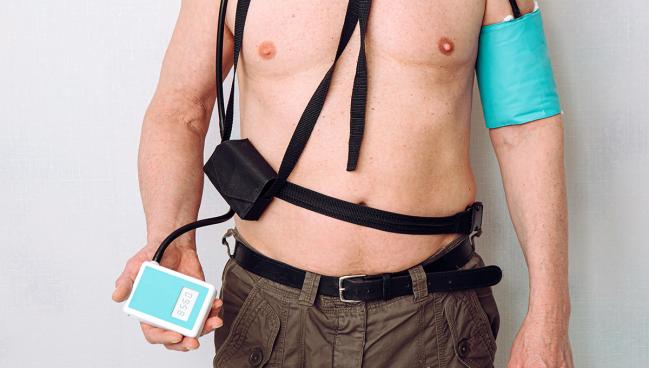Tight Link Between Ambulatory BP and Mortality Affirmed in Revamped Analysis
The study follows a prior one retracted due to data problems, with the information now “rescued for reliable analyses.”

Ambulatory blood pressure readings, particularly those recorded at night, provide a better indication of a patient’s risk of mortality over the next several years than do clinic-based measurements, a large Spanish study confirms, reinforcing findings from numerous previous studies.
Among patients in the top four quintiles of BP, a 1-SD increase in 24-hour systolic BP had a stronger association with all-cause mortality over a median follow-up of about decade than did a similar increase in clinic-based systolic BP (HR 1.41 vs 1.18). The relationship with 24-hour systolic BP remained robust after adjustment for clinic-based readings, but the association with clinic-based BP was weakened once ambulatory readings were taken into account.
Those findings, published online recently in the Lancet, bolster prior research around ambulatory blood pressure monitoring (ABPM), senior author Bryan Williams, MD (University College London Hospitals NHS Foundation Trust, England), told TCTMD via email, noting that “what this study provides is enormous power because of its size and the duration of follow-up.”
The study reinforces “the recommendation that ABPM or home BP as an alternative play an important role in confirming the diagnosis of hypertension, especially in those with less-severe hypertension, and in my view, should be used to confirm quality of BP control, especially in higher-risk patients or those in whom nighttime BP is likely to be more elevated—ie, those with diabetes, chronic kidney disease, other forms of secondary hypertension, or sleep apnea,” Williams said.
Fixing Data Problems
The findings might sound familiar because this research group previously released a similar analysis in the New England Journal of Medicine in 2018. But after questions were raised about the earlier data, a statistical review confirmed problems, leading to the retraction of the study and another paper in Hypertension that relied on similar data. Commentators at the time said the retraction shouldn’t undermine the total body of evidence supporting ABPM.
“Problems with the original analysis related to errors in the primary linkage of the national mortality data to the Spanish registry data,” Williams said, noting that an account of what happened and how it was resolved by a new statistical team from the University of Oxford can be found in the appendix for this latest paper. “This is completely new data linkage and a new analysis with updated mortality data and longer follow-up through 2019,” Williams explained.
Giuseppe Mancia, MD (University of Milano-Bicocca, Milan, Italy), provides his perspective on the situation in an accompanying comment, stating that “because of the efforts of some of the authors, the inaccuracies have now been eliminated and the database meritoriously rescued for reliable analyses.”
Nighttime Readings Most Informative
The new analysis, with lead authors Natalie Staplin, PhD (University of Oxford, England), and Alejandro de la Sierra, MD, PhD (MútuaTerrassa University Hospital, University of Barcelona, Spain), focuses on ambulatory and clinic BP measurements spanning March 2004 and December 2014 collected within the Spanish Ambulatory Blood Pressure Registry, which includes patients seen at 223 primary care centers across Spain.
Investigators examined data on 59,124 patients (mean age 58.7 years; 47% women), most of whom (59.4%) were being treated for hypertension at baseline. Average BP at baseline was 148/87 mm Hg in the clinic and 129/76 mm Hg on ABPM.
During a median follow-up of 9.7 years, 12.1% of patients died, including 4.0% from cardiovascular causes. Consistent with prior research, there were J-shaped associations between BP and mortality.
The researchers divided the cohort into quintiles according to BP, and when focusing on the top four quintiles, there was a stronger correlation between 24-hour systolic BP and all-cause mortality than between clinic-based systolic BP and that endpoint, with similar findings for CV death. Whether patients were being treated for hypertension at the beginning of follow-up had no impact on the results.
The investigators estimated that 24-hour systolic BP was nearly five times as informative for risk of all-cause and CV death as clinic-based readings, with nighttime readings being even more informative.
Williams cited three reasons to explain the tighter relationship between ABPM and mortality than between clinic-based measurements and mortality. “First, clinic blood pressure is often not measured in routine clinical practice under standardized conditions, as recommended in guidelines,” he said. “Second, clinic blood pressure will fail to detect masked hypertension and white coat hypertension. Therefore, clinic blood pressure will underestimate the risk of those with masked hypertension and overestimate the risk in those with white coat hypertension.”
And third, he said, “ambulatory readings capture more information about the usual blood pressure during the day and, importantly, during sleep.”
In assessing the impact of different BP phenotypes on mortality risk, Williams and colleagues found that the hazard of all-cause death was greater in patients with masked hypertension (HR 1.24; 95% CI 1.12-1.37) or sustained hypertension (HR 1.24; 95% CI 1.15-1.32), but not among those with white coat hypertension. The findings were similar for CV mortality.
Though white coat hypertension wasn’t associated with mortality risk, “many of these patients will develop sustained hypertension and their risk will then increase,” Williams noted.
Gaps in Knowledge Remain
In his editorial, Mancia notes that the main findings, and some of the secondary results, are consistent with prior research. “But their demonstration via a large cohort gives these results a scientific weight that goes beyond a confirmatory value,” he specifies.
Still, not all of the findings are in line with previous studies, he says, pointing to prior meta-analyses—including one in the Journal of Hypertension and one in the Annals of Internal Medicine—showing a link between white coat hypertension and mortality, in contrast to what was shown here.
There are also lingering questions around how much ABPM improves the prediction of outcomes compared with clinic-based measurements, he says, adding that there are potential limitations with the current analysis stemming from some of the data adjustments and the lack of information on the quality of the clinic BP measurements, which can vary widely in practice.
Mancia’s own research has suggested that strengthening the quality of clinic BP measurements with standardization and certified readers may improve their prognostic value, “raising the question of whether for hypertension a better and simpler future strategy to improve diagnosis and risk evaluation might be to rely on a generalized improvement of clinic blood pressure measurements rather than on routine ambulatory blood pressure monitoring.”
An additional limitation of this and other studies, Mancia continues is the lack of information on age-related BP changes, on changes in and adherence to antihypertensive treatment and other therapies, and on other variables during long-term follow-up.
“This absence of information is a serious limitation when the aim is to assess the prognostic value of hypertension phenotypes (ie, masked hypertension, white coat hypertension, and nocturnal blood pressure patterns) whose reproducibility is extremely poor,” he argues.
Future studies, he concludes, “should aim to implement longitudinal studies based on serial ambulatory blood pressure measurements as well as randomized outcome-based controlled trials comparing treatments guided by clinic blood pressure with treatment guided by out-of-office blood pressure.”
Williams acknowledged the lack of data on using ABPM to guide treatment decisions, saying, “Hopefully that will change.”
And, he added, “as technology evolves, bolstered by the evidence here, one would hope it will be possible to create easier-to-wear blood pressure measurement technologies to provide more-convenient measurement of ambulatory blood pressure in the future.”
Todd Neale is the Associate News Editor for TCTMD and a Senior Medical Journalist. He got his start in journalism at …
Read Full BioSources
Staplin N, de la Sierra A, Ruilope LM, et al. Relationship between clinic and ambulatory blood pressure and mortality: an observational cohort study in 59 124 patients. Lancet. 2023;Epub ahead of print.
Mancia G. Evidence in favour of ambulatory blood pressure grows but gaps in knowledge remain. Lancet. 2023;Epub ahead of print.
Disclosures
- The study was supported and funded by the Spanish Society of Hypertension, Lacer Laboratories, and European government agencies. The Medical Research Council Population Health Research Unit at the University of Oxford, which is part of the Clinical Trial Service Unit and Epidemiological Studies Unit, receives core funding from the UK Medical Research Council. The investigators also received support from Health Data Research UK, National Institute for Health and Care Research Biomedical Research Centres at Oxford and University College London Hospitals, and British Heart Foundation Centre for Research Excellence, Oxford.
- Staplin reports institutional grant support from Boehringer Ingelheim, Lilly, and Novo Nordisk for investigator-led/designed research unrelated to this study.
- Williams reports lecture fees from Daichi Sankyo, Servier, and Pfizer, and institutional grant support from Omron for investigator-designed/led research unrelated to this study. On behalf of University College London, Williams has received an investigator-led grant award from Omron, Japan, and honoraria for lectures on blood pressure measurement, and is supported by the National Institute for Health and Care Research University College London Hospitals Biomedical Research Centre.
- Mancia reports having received payments, honoraria, or reimbursement of travel expenses from AstraZeneca, Boehringer Ingelheim, Berlin Chemie, Gedeon Richter, Medtronic, Menarini, Merck, Recordati, Sandoz, Sanofi, and Servier, all of which are unrelated to the content of his comment.


Comments